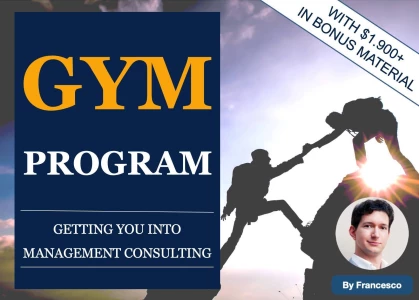Hi Anonymous,
this is what I would recommend to consider for the presentation part:
A) structure the order of the slides
For many presentations following a written case 5 slides are enough to present your findings. You can structure them as follows:
- First slide sums up the question and provides the answer
- Second, third and fourth slide have the supporting arguments for the first slide
- Fifth slide provides the next steps
B) structure the content of each slide
There are three basic components for slides:
- Title
- Chart or data
- Label for chart
Many people structure the title as the mere description of what the chart is telling. A great title, instead tells the implication of the graph. Eg say the graph is showing a cost structure for a division. A bad title would be: Cost structure from 2005 to 2015. A good title would be: Cost structure of Division XYZ is not sustainable”. A great title would be Cost structure of Division XYZ is not sustainable due to ABC, assuming you have insides on the cause. The rule of thumb for the title is that if you read all the titles of the slides together you should get a clear idea of what is going on.
C) structure the presentation of the slides
When you present, I would suggest the following steps for each slide:
- Introduce the slide: “Let’s move to slide 2, which will show us why we have an issue with this division”
- Present the main message of the slide: “As you can see, we have a cost structure which makes for us not feasible to be competitive in this market”
- Provide details: “The graph, indeed, shows how our fix cost is XYZ, while competitors can benefit from economies of scale. Indeed…”
As general tips for the analysis for the information before the presentation, you could consider the following 5 areas:
1. Learn how to define a plan of action and stick to that
The first thing you should do in a written case is to define a plan and allocate in the best possible way your time. Assuming 60 minutes for the analysis, a good approach would include:
- initial quick reading – 10-20 min (this may depend on the amount of material)
- structure the approach – 5 min
- make slides/answer to the questions adding detailed analysis and math – 25-35 min
- final review – 10 min
You should then practice to stick to the time allocated, in order to maximize your final performance.
2. Practice graph interpretation
You will normally have to analyse graphs in a written case. The best way to practice is to take graphs from online resources and use a timer to test in how much time you can understand the key message. McKinsey PST graphs could be a good practice for that.
3. Work on quick reading and quick understanding of key information
You will not have time to read and prioritize everything, so you have to understand where to focus. The ideal way to practice is to use long cases such as HBS ones, and practice on reducing the time needed to absorb the key information that can answer a defined question. Quick reading techniques could also help.
4. Practice quick math
You will normally have math to do in a written case. GMAT and McKinsey PST math should work well to prepare on this.
5. Learn how to communicate your slides/answers
You may have to present your findings at the end of the case. Although as mentioned it will require more time, I would apply the same structures of final sum up in a live interview case, that is:
- Sum up the main questions you have to answer
- Present your proposed answer and detail the motivation behind
- Propose next steps for the areas you have not covered
As you will not be able to double check hypothesis with the interviewer as in the live case before the presentation, you should clearly state when you are making hypotheses and that you will have to verify them with further analysis.
Hope this helps,
Francesco








